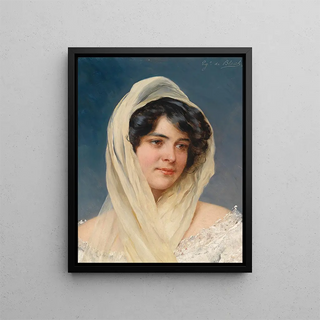Art print | Portrait of a young woman with a veil - Eugen von Blaas


View from behind

Frame (optional)
Portrait of a Young Woman with a Veil - Eugen von Blaas – Captivating Introduction
In the fascinating world of art, some works manage to capture the very essence of beauty and human emotion. The "Portrait of a Young Woman with a Veil" by Eugen von Blaas is one of those creations that transcend time and space. This piece, imbued with delicacy and mystery, invites the viewer to immerse themselves in a world where light dances across the contours of faces and where every detail tells a story. The young woman, both present and distant, seems to look at us through a veil of secrets, awakening an insatiable curiosity within us.
Style and uniqueness of the work
Eugen von Blaas, master of portraiture, deploys here a subtle and refined palette of colors. The soft hues, ranging from cream shades to golden highlights, envelop the female figure with an aura of serenity. The veil, finely draped, plays a central role in the composition, adding a dimension of mystery while highlighting the grace of the model. The artist's technique, blending realism and romanticism, captures not only the physical beauty of the young woman but also a psychological depth that evokes emotion. Every brushstroke seems to be a caress, every shadow a promise of revelations to come. This portrait is much more than a simple representation; it is an invitation to contemplate the soul of its subject.
The artist and his influence
Eugen von Blaas, born in 1843 in Venice, is an artist who established himself in the 19th-century art scene. Trained by the great masters of his time, he developed a unique style that combines academic tradition with modern sensitivity. His work is often marked by meticulous attention to detail and an ability to capture light in a way that gives his works an almost palpable life. Blaas was influenced by the Pre-Raphaelite movement, whose themes of beauty and nature are reflected in his portraits. By choosing to depict women in elegant poses, often dressed in traditional clothing, he created a link between the past and the present, paying homage to the timeless beauty of

Matte finish

View from behind

Frame (optional)
Portrait of a Young Woman with a Veil - Eugen von Blaas – Captivating Introduction
In the fascinating world of art, some works manage to capture the very essence of beauty and human emotion. The "Portrait of a Young Woman with a Veil" by Eugen von Blaas is one of those creations that transcend time and space. This piece, imbued with delicacy and mystery, invites the viewer to immerse themselves in a world where light dances across the contours of faces and where every detail tells a story. The young woman, both present and distant, seems to look at us through a veil of secrets, awakening an insatiable curiosity within us.
Style and uniqueness of the work
Eugen von Blaas, master of portraiture, deploys here a subtle and refined palette of colors. The soft hues, ranging from cream shades to golden highlights, envelop the female figure with an aura of serenity. The veil, finely draped, plays a central role in the composition, adding a dimension of mystery while highlighting the grace of the model. The artist's technique, blending realism and romanticism, captures not only the physical beauty of the young woman but also a psychological depth that evokes emotion. Every brushstroke seems to be a caress, every shadow a promise of revelations to come. This portrait is much more than a simple representation; it is an invitation to contemplate the soul of its subject.
The artist and his influence
Eugen von Blaas, born in 1843 in Venice, is an artist who established himself in the 19th-century art scene. Trained by the great masters of his time, he developed a unique style that combines academic tradition with modern sensitivity. His work is often marked by meticulous attention to detail and an ability to capture light in a way that gives his works an almost palpable life. Blaas was influenced by the Pre-Raphaelite movement, whose themes of beauty and nature are reflected in his portraits. By choosing to depict women in elegant poses, often dressed in traditional clothing, he created a link between the past and the present, paying homage to the timeless beauty of






